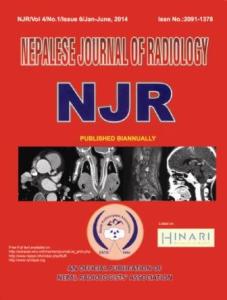Triphasic Contrast Agent Injection in 64-MDCT Coronary Artery Angiography
DOI:
https://doi.org/10.3126/njr.v4i1.11365Keywords:
Coronary artery, Triphasic injection, Computed tomography' Enhancement' ROIAbstract
Purpose: To evaluate image quality and cardiovascular enhancement after triphasic injection in 64-slice-CT coronary angiography (c-CTA).
Methods: c-CTA of twenty-two asymptomatic patients following triphasic injection (65ml-contrast bolus + mixed 30ml-contrast and 20ml-saline bolus + 50ml-saline chaser) were retrospectively reviewed. Attenuation in the great vessels, cardiac chambers, and coronary arteries in 13 places were measured by region of interest. Also, differences in enhancement between the right coronary artery (RCA) and the right cardiac chambers (RCA versus right atrium or RA; RCA versus right ventricle or RV) were analyzed. Quality of images and contrast-related streak artifacts were subjectively assessed by 2 radiologists in consensus on a 4-point scale.
Results: There was excellent enhancement in the coronary arteries (mean range 395.84-429.90 Hounsfield Units or HU), ascending aorta (mean 448.58 HU), descending aorta (mean 433.49 HU), and pulmonary artery (mean 385.45 HU). There was adequate difference in attenuation between RCA versus RA (mean range 126.12-148.43 HU) and RCA versus RV (mean range 50.34-72.66 HU). There was high and inhomogeneous attenuation in the superior vena cava (mean 509.23 HU). The quality of images was considered good (mean 1.6; 1 = excellent, 2 = good, 3 = moderate, 4 = low) and contrast-related streak artifacts were considered low (mean 2.9; 1 = severe, 2 = moderate, 3 = low, 4 = absent) by two radiologists.
Conclusions: Our triphasic contrast injection provides excellent cardiovascular enhancement with minimal contrast-related streak artifacts, particularly in the right cardiac chambers while adequately differentiating the right coronary artery.
DOI: http://dx.doi.org/10.3126/njr.v4i1.11365
Nepalese Journal of Radiology, Vol.4(1) 2014: 12-22
Downloads
Downloads
Published
How to Cite
Issue
Section
License
This license enables reusers to distribute, remix, adapt, and build upon the material in any medium or format, so long as attribution is given to the creator. The license allows for commercial use.




